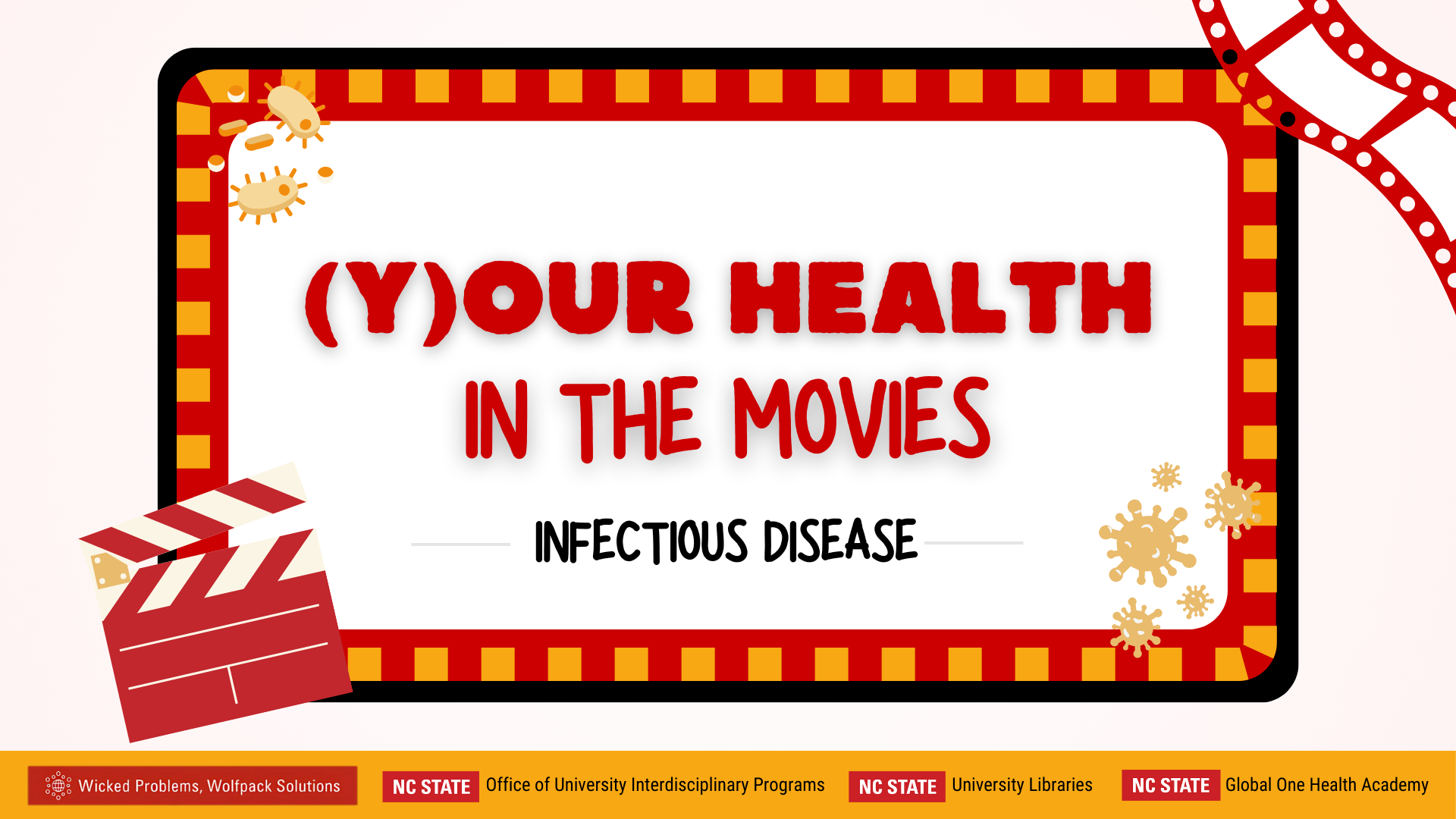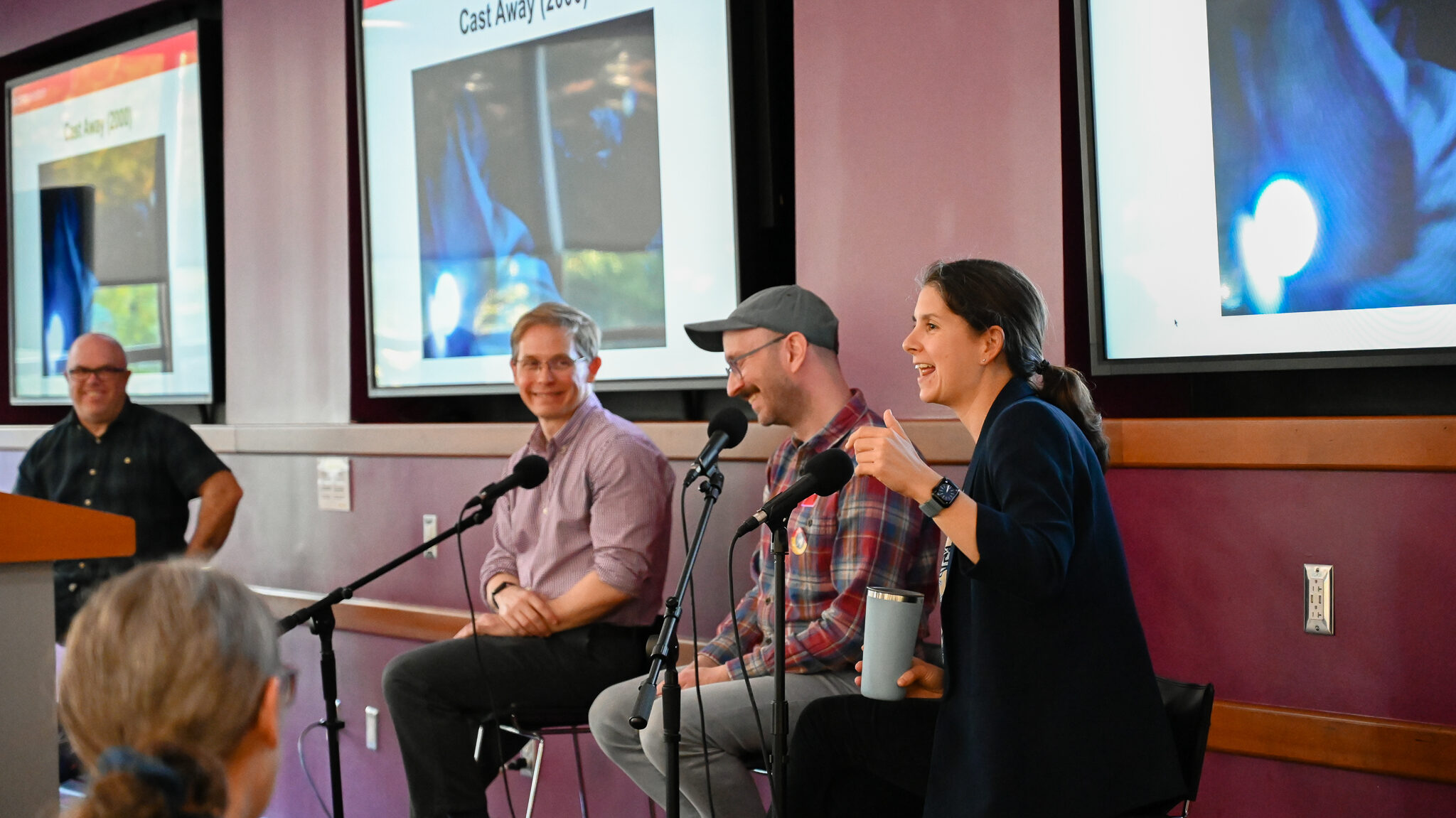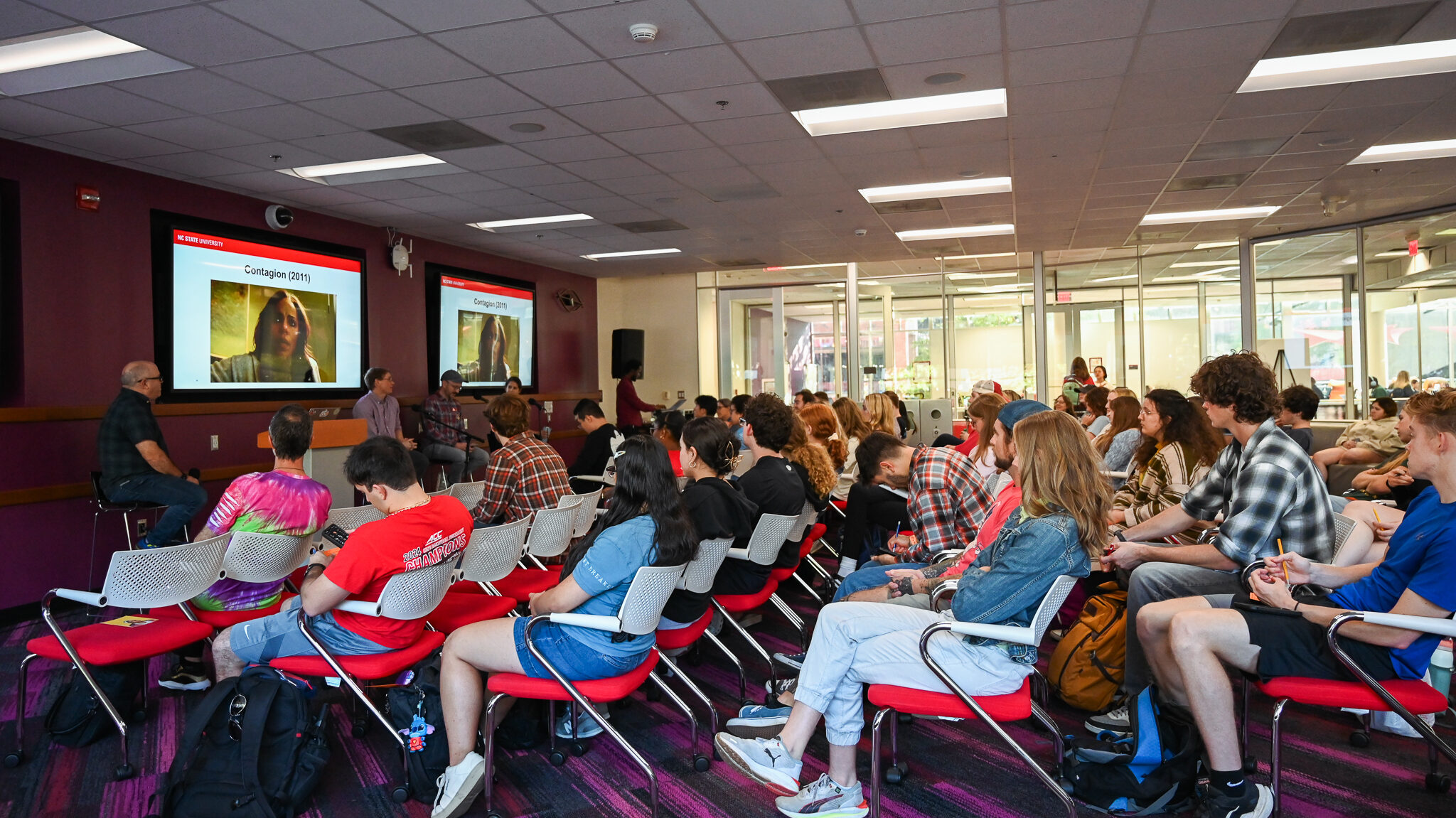(Y)Our Health in the Movies: Infectious Disease

On Thursday, October 24, students, faculty, and staff packed the Fishbowl Forum to learn about popular depictions of infectious disease in the movies during the (Y)Our Health in the Movies: Infectious Disease event. This event is part of the (Y)Our Health in the Movies series and is co-sponsored by the Office of University Interdisciplinary Programs, the NC State University Libraries, the Global One Health Academy, and Wicked Problems, Wolfpack Solutions.
“Are you sure it wasn’t that gray kind of lamb? Or you ate a lot of that weird chicken, was it that?” – Bridesmaids (2011)
Sometimes the source of foodborne illnesses may not be as glaringly obvious as was the case in this unforgettable Bridesamids food poisoning scene. For those who have never seen the movie, let’s set the scene. A group of friends have just finished up lunch and are going dress shopping for their friend’s wedding. Unfortunately, due to some questionable meat, most of the women begin to fall ill. Portrayed in a comedic light, the women are seen running to the toilet, sink, and even the street as they are overcome with extreme gastrointestinal upset. While making for a priceless piece of comedy and entertainment, scientist Angela Harris explained that identifying the source of food poisoning may not be as straightforward (or funny for that matter). Additionally, not everyone who consumes the food will necessarily have the same reaction or even get sick at all. Should you ever be as unlucky as these friends, Wake County has a method to report any potential foodborne illness acquired from a restaurant or large gathering.
Harris also provided some tips on how to survive if you ever find yourself without access to clean water or on a deserted island like Tom Hanks in Cast Away (2000). In the clips shared, Hanks’s character is seen desperately slurping water from a leaf on the ground and then later collecting rainwater during a storm. Although harvesting rainwater can be a practical solution for obtaining clean drinking water, Harris cautioned that consuming water from the ground may expose you to various contaminants collected along the way.

In addition to Bridesmaids and Cast Away, clips from Outbreak (1995), Contagion (2011), And the Band Played On (1993), and How to Survive a Plague (2012) were also shared during this event. Films were selected by subject matter experts to discuss the accuracy of the science portrayed, as well as changing cultural perceptions over time.
Outbreak, a dramatic thriller featuring Dustin Hoffman as Colonel Sam Daniels, a virologist for the U.S. Army, follows the story of a deadly virus transported from Africa to North America by a white-headed Capuchin monkey. In the movie, this virus first appeared in 1967 in the African jungle, but was contained after the U.S. Army destroyed the camp containing infected soldiers. Twenty-eight years later, the virus has resurfaced in Africa and now spread to North America, where it has mutated into a more airborne influenza like strain in small town called Cedar Creek. After determining that his Superior Officer plans to bomb the infected town, Daniels is in a race against time to develop an antiserum to not only save his ex-wife (Dr. Keough) but also the whole town. To do so, he captures the infected monkey, mixes its antibodies with an experimental serum developed for the original strain, and then quickly injects Keough, saving her in the nick of time. This anti-serum mixture is then also distributed to the entire town, ridding the infection from the area. While this unfortunately is scientifically implausible, as pointed out by scientist Matt Koci, it certainly does make for a great dramatic thriller!
Contagion, on the other hand, has been praised for its scientific accuracy. Director Steven Soderbergh was motivated to create a film strongly based in scientific fact. He even contacted Dr. W. Ian Lipkin, virologist and professor at Columbia University, to assist in the writing and making of the film. The story follows a highly contagious zoonotic virus that originates in Hong Kong and ultimately develops into a deadly worldwide pandemic. At the time of the film’s release, scientists critiqued the vaccine development process for being too quick. However, when compared with COVID-19, Koci found an eerie similarity. In the film, the time from when the first case was documented and when the doctor injects herself with the vaccine was 135 days – about the same time it took the U.S. to begin human trials after the first infection in the country. One aspect of reality the film could not fully predict, was the level and breadth of distrust toward the CDC and healthcare professionals during the pandemic. The film did, however, have one conspiracy theorist character played by Jude Law, perhaps foreshadowing the widespread unrest experienced during the COVID-19 pandemic.

From virulent zoonotic diseases, the conversation transitioned to HIV/AIDS with a clip from And the Band Played On featuring Matthew Modine as epidemiologist Dr. Don Francis. In the scene, Francis speaks to a room of gay men about the dangers of the virus and the plan to close the bathhouses, which results in an uproar from the crowd. Film scholar John Stadler explained how the closing of the bathhouses marked a pivotal point for the gay community, stripping them of their dignity and furthering the controversies between public health and gay civil liberties.
This fictional film was then followed by the documentary How to Survive a Plague which tells the story of the important role of grassroots movements in developing life-saving drugs to treat HIV. During the 1980s, access to primary scientific information was not as easy as it is today. The only source for information was the local news, which some groups were skeptical of during this time. Additionally, scientific journals were only accessible at the libraries and through a tedious process. Taking matters into their own hands, a passionate group of men and women gathered together to read scientific articles and educate themselves on the virus and deadly disease. Due to their concerted effort, these activists transformed HIV/AIDS from a death sentence into a manageable disease.
While infectious diseases may inspire captivating and thrilling fictional films, they are a very real threat. However through a One Health approach, we can protect and promote the wellness of all living beings, enhance public health resilience, and safeguard ecological balance. By increasing awareness of the global burden of infectious diseases through prevention, detection, and response strategies, we can save lives, improve public health, and foster sustainable development worldwide.
We would like to thank our expert panel for providing valuable insight into the spread of infectious diseases and to Jory Weintraub (OUIP) for facilitating the panel. Panelists included: Angela Harris (Civil, Construction, and Environmental Engineering), Matt Koci (Poultry Science), and John Stadler (English).
Be sure to join us for (Y)Our Health in the Movies: Climate Change on January 30, 2025!
- Categories: